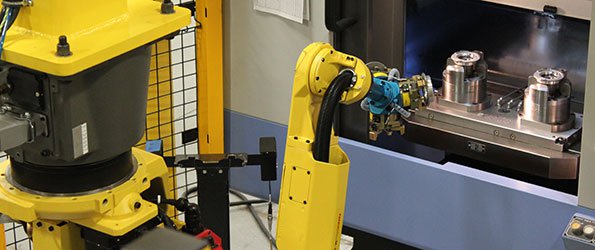
Machine Tending: Is It Truly a Robot’s Paradise?
Jason Nowak | 16 October 2014
Machine tending can be some of the most grueling and hazardous work conditions for an industrial operator. Day in and day out, operators are subjected to repetitive tasks, potential cutting or pinching hazards, and are still required to maintain high quality and a maximum throughput. Many times increasing your throughput means a reduction in quality, but with the help of industrial robots you can maximize both of these requirements while providing your operators with a safer working environment. So is machine tending truly a robot’s paradise? Many would say yes.
Robots are not affected by the repetitiveness of a task or by how long or grueling that task is. Robots are made to be placed in situations to help reduce a potential hazard or to maintain the high level of quality that a process requires. However, this doesn’t come as easily as just placing a robot in the same spot as an operator.
There are many factors that need to be reviewed and addressed to make sure you achieve the quality and throughput that your process requires. Some of these factors include:
- Process flow
- How does the product move through the facility and what is the optimal location to place the robotic cell?
- Desired throughput and number of machines needed
- Sometimes, multiple robots are required to achieve the desired throughput
- In other cases, a single robot has capacity to tend multiple machines
- Machine to robot interlocks
- How will the robot interact with the machine?
- Infeed and outfeed of parts
- Where or how are parts moved into and out of the cell?
- Part orientation
- How is the part positioned when it enters the cell?
- What orientation does the machine require the part to be in?
- Robot grippers
- Which type of end of arm tool is most effective for your product?
- Vision to positively locate parts and/or part verification
- Vision is also capable of identifying defective products
- Quarantine of rejected parts
- If a part is rejected, what is the procedure for removing it from the cell?
This is where Bastian Robotics can step in. We can help you review your current process or propose a new one to help maximize its potential, all while keeping it as cost-effective as possible. We will work with you to address all the factors stated above to ensure your robotic machine tending system is installed correctly and operates smoothly, while maintaining the high quality your process demands.
Please contact us today if you are interested in a machine tending system for your next industrial project.
Jason is a Bastian Solutions Senior Consultant based out of St. Louis, Missouri. He has a Bachelor of Science in Mechanical Engineering from Missouri S&T and an MBA from St. Louis University. Jason has been providing manufacturing and distribution design and integration leadership across various industries for Bastian Solutions’ clients for over 15 years, helping clients develop strategic initiatives and lead successful system implementations.
Comments
No comments have been posted to this Blog Post
Leave a Reply
Your email address will not be published.
Comment
Thank you for your comment.